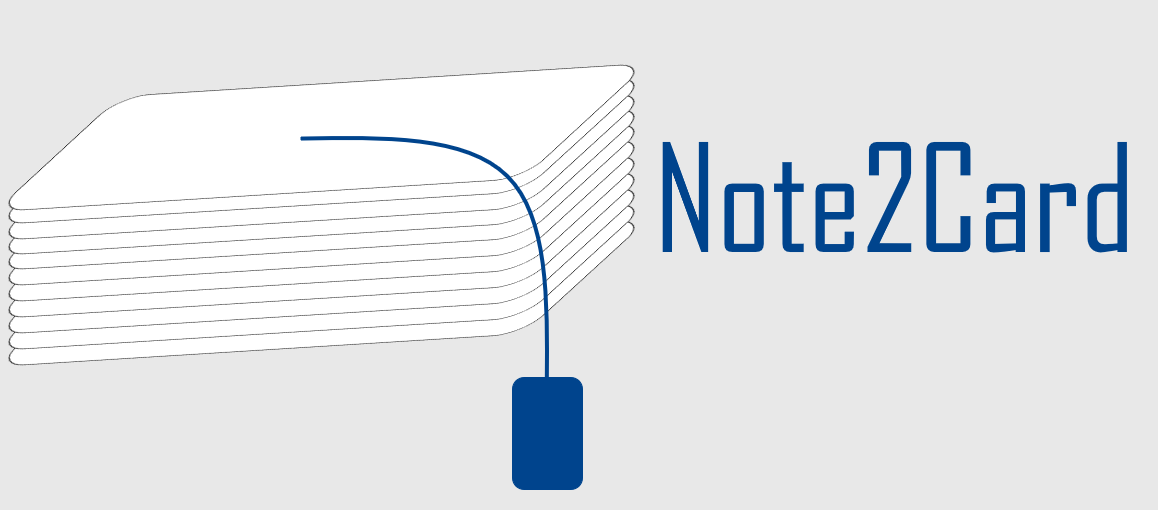Straight from lecture notes to flashcards
No more wasting time by manually typing in all your many flashcards before you actually get to studying. Just upload your lecture notes and the program will extract the flashcards for you.
Note2Card (version 1.1) is not yet available for download.
Note2Card
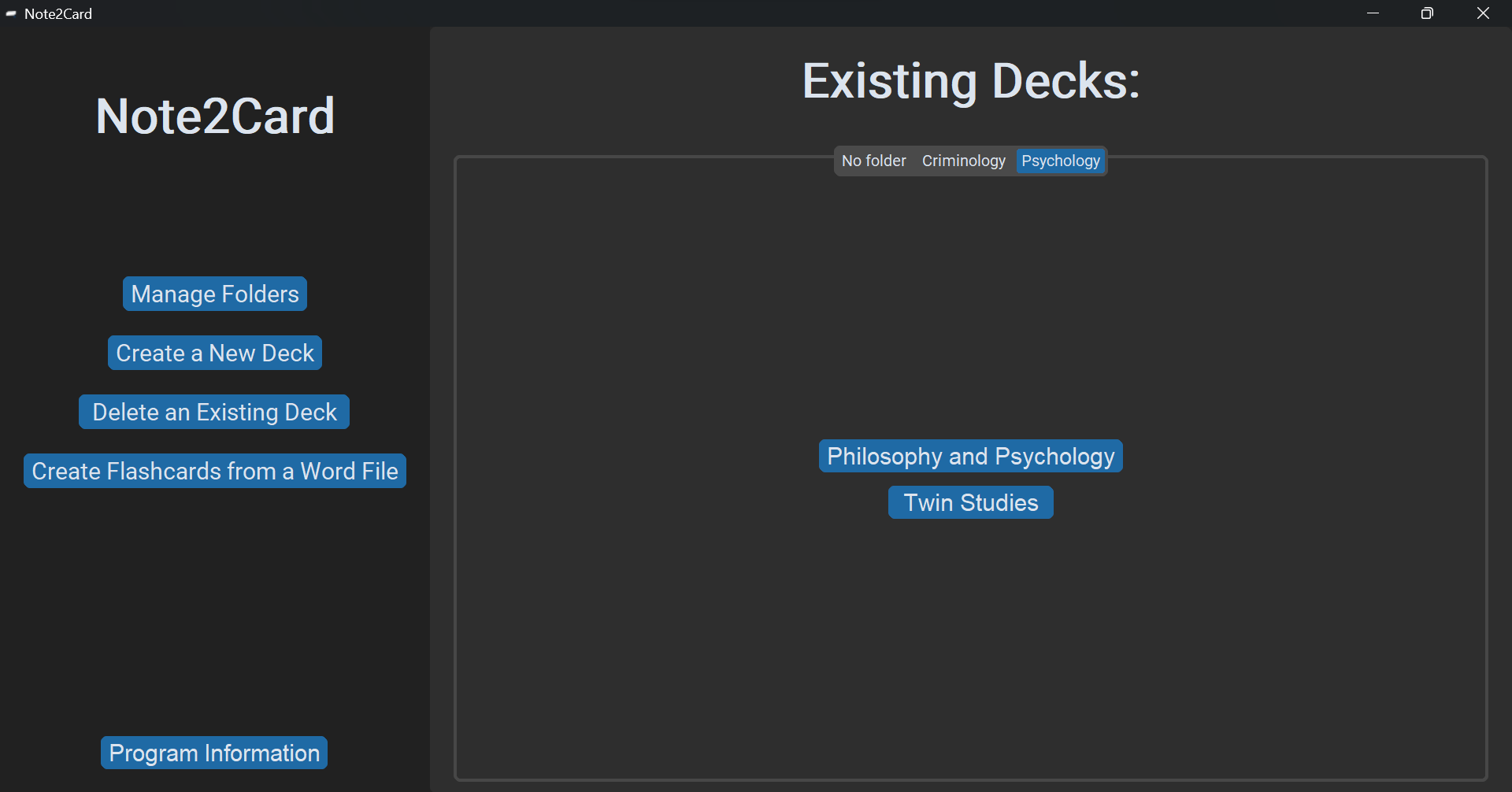

The program allows you to extract your flashcards from a Word file. You can just upload your lecture notes and the program will extract the flashcards from it for you, given that they are formatted like this: ‘CONCEPT: Definition_’.
No more wasting time by manually creating flashcards.
Straight from
lecture notes
to flashcards
No more wasting time by manually typing in all
your many flashcards before you actually get
to studying. Just upload your lecture notes and
the program will extract the flashcards for you.
Note2Card

The program allows you to extract your flashcards from a Word file. You can just upload your lecture notes and the program will extract the flashcards from it for you, given that they are formatted like this:
‘CONCEPT: Definition_’
No more wasting time by manually creating flashcards.

Decks
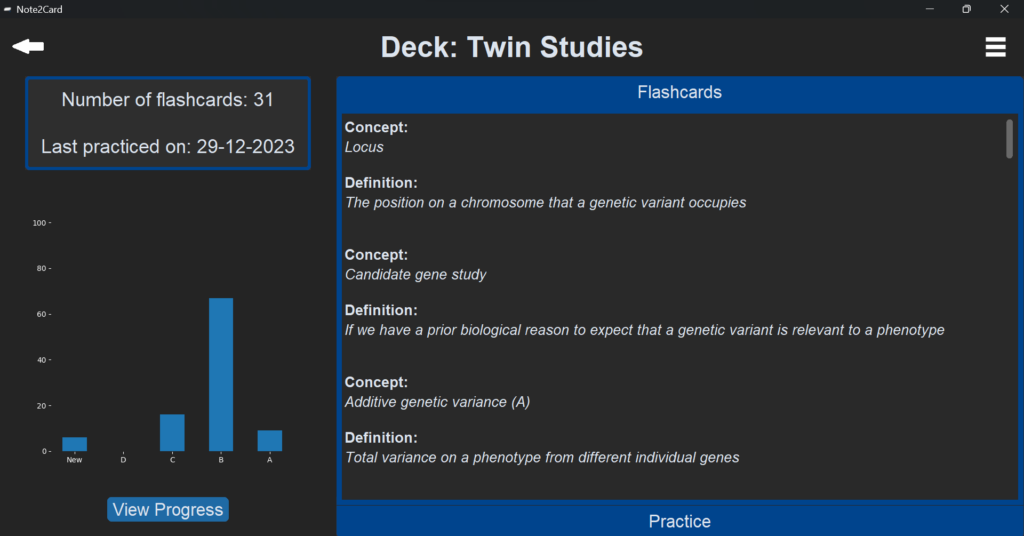
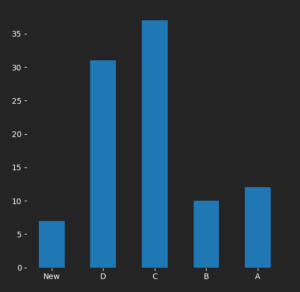
Progress
You can immediately see how you are progressing with your deck. The bar chart shows it at a glance and you can see it in more detail by pressing the ‘View Progress’ button. This way, you will know when you are ready for your test.
Practice
Note2Card uses a special algorithm for rehearsing your flashcards. The program will focus on rehearsing flashcards that still take some effort to recall, so there is no time wasted studying flashcards you already know!
To optimize this process, the program will keep up to 15 of the harder flashcards in rotation. This allows you to actually learn the concepts before adding new flashcards.
Some science
Out of ten commonly used studying techniques, practice testing and distributed practicing appear to be the two most effective (Dunlosky et al., 2013). Both these techniques can be employed when using flashcards (Wissman et al., 2012). Furthermore, concepts that are processed more deeply are remembered better (Torun & Altun, 2014).
So, even though our flashcards algorithm and deep learning mode have themselves not been tested empirically, it has a rich theoretical and empirical background.
Dunlosky, J., Rawson, K. A., Marsh, E. J., Nathan, M. & Willingham, D. T. (2013). Improving students’ learning with effective learning techniques: Promising directions from cognitive and educational psychology. Psychological Science in the Public Interest 14(1): 4–58.
Torun, E. D. & Altun, A. (2014). The effect of levels of processing with navigation design types on recall and retention in e-learning environments. Behaviour & Information Technology, 33(10), 1039-1047.
Wissman, K., Rawson, L. & Pyc M. (2012). How and when do students use flashcards? Memory 20(6), 568–579.
Practice modes
Regular Learning Mode
This mode will allow you to just rehearse your flashcards. The mode still employs the algorithm where it keeps 15 of the harder flashcards in rotation. Other than that, it is just plain studying through repetition. Perfect for when you need to memorize dry facts.
Reversed Learning Mode
This mode is similar to the regular learning mode, but in reverse. So you will be presented with the definition and you need to remember the concept corresponding to that definition. Switching things up sometimes is generally good practice.
Deep Learning Mode
The deep learning mode extends on the regular learning mode. It offers all the same benefits, but also facilitates deeper processing of the concepts you are studying. After rehearsing a flashcard, you will be asked a question. You may for example be asked: ‘Could you give an example for that concept?’ This will facilitate deeper processing of the concept and that will in turn increase retention. Therefore, this mode is ideally suited for studying concepts and theories, rather than studying words in order to learn a new language.
Some science
Out of ten commonly used studying techniques, practice testing and distributed practicing appear to be the two most effective (Dunlosky et al., 2013). Both these techniques can be employed when using flashcards (Wissman et al., 2012). Furthermore, concepts that are processed more deeply are remembered better (Torun & Altun, 2014).
So, even though our flashcards algorithm and deep learning mode have themselves not been tested empirically, it has a rich theoretical and empirical background.
Dunlosky, J., Rawson, K. A., Marsh, E. J., Nathan, M. & Willingham, D. T. (2013). Improving students’ learning with effective learning techniques: Promising directions from cognitive and educational psychology. Psychological Science in the Public Interest 14(1): 4–58.
Torun, E. D. & Altun, A. (2014). The effect of levels of processing with navigation design types on recall and retention in e-learning environments. Behaviour & Information Technology, 33(10), 1039-1047.
Wissman, K., Rawson, L. & Pyc M. (2012). How and when do students use flashcards? Memory 20(6), 568–579.
Practice modes
Regular Learning Mode
This mode will allow you to just rehearse your flashcards. The mode still employs the algorithm where it keeps 15 of the harder flashcards in rotation. Other than that, it is just plain studying through repetition. Perfect for when you need to memorize dry facts.
Reversed Learning Mode
This mode is similar to the regular learning mode, but in reverse. So you will be presented with the definition and you need to remember the concept corresponding to that definition. Switching things up sometimes is generally good practice.
Deep Learning Mode
The deep learning mode extends on the regular learning mode. It offers all the same benefits, but also facilitates deeper processing of the concepts you are studying. After rehearsing a flashcard, you will be asked a question. You may for example be asked: ‘Could you give an example for that concept?’ This will facilitate deeper processing of the concept and that will in turn increase retention. Therefore, this mode is ideally suited for studying concepts and theories, rather than studying words in order to learn a new language.
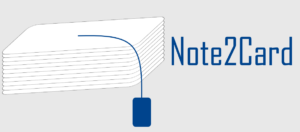
Contact:
E-mail: Note2Card@gmail.com
